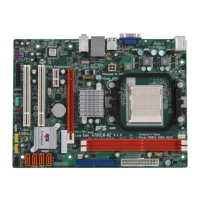
Do you have a question about the ECS A780LM-M and is the answer not in the manual?
| Brand | ECS |
|---|---|
| Model | A780LM-M |
| Category | Motherboard |
| Language | English |
Provides an overview of the A780LM-M motherboard and its target market.
Details the key features of the motherboard's processor, chipset, memory, and audio.
Describes the motherboard's expansion slot types: PCI Express x16, PCI Express x1, and PCI slots.
Lists the available rear panel I/O ports and internal connectors for system connectivity.
Explains the capabilities of the AMI BIOS for system configuration and management.
Lists the technical specifications of the motherboard, including CPU, chipset, memory, I/O, and form factor.
Illustrates and identifies the various components and connectors on the motherboard.
Outlines essential safety measures to follow before and during motherboard installation to prevent damage.
Guidance on selecting a compatible computer case based on motherboard specifications and features.
Step-by-step instructions for physically mounting the motherboard inside a computer case.
Explains how to identify and set motherboard jumpers for correct system configuration.
Details specific jumper settings for CLR_CMOS, USBPWR_F1, and USBPWR_R1.
Details the procedure for installing hardware components like the CPU and memory modules.
Step-by-step guide for installing the CPU onto the motherboard socket, including thermal grease application.
Instructions for properly installing DDR3 SDRAM memory modules into the motherboard slots.
Follows instructions to install an add-on card into an expansion slot.
Provides information on connecting front panel USB headers to the motherboard.
Details the pinout for the onboard parallel port header for connecting printers or scanners.
Explains the connection for auxiliary front-oriented microphone and line-out ports.
Describes the SATA connectors for connecting storage devices with high data transfer rates.
Details the optional header for S/PDIF digital audio output.
Explains the header for detecting chassis cover removal, requiring BIOS configuration.
Provides pinout for connecting a serial port extension bracket to add a second serial port.
Guides the user through installing IDE and SATA hard drives and CD-ROM drives.
Shows how to properly connect SATA cables and power for hard drives.
Explains how to connect external devices to the motherboard's rear I/O ports.
Details connecting internal case components like fans, power connectors, and front panel headers.
Details connections for power, reset switches, and hard drive activity LEDs on the front panel header.
Introduces the BIOS Setup Utility and its role in configuring system parameters.
Discusses the default BIOS settings and when it's appropriate to make changes.
Provides instructions on how to access the BIOS Setup Utility during system startup.
Explains how to load default BIOS settings to resolve configuration issues.
Lists the keyboard shortcuts used for navigating and operating the BIOS Setup Utility.
Details the options available in the Standard CMOS Setup for date, time, and storage devices.
Explains how to configure IDE Master/Slave and SATA device settings in the BIOS.
Covers advanced system settings, including CPU, memory, and boot device configurations.
Explains settings related to the motherboard chipset, such as internal graphics and memory.
Manages settings for onboard peripherals like IDE, SATA, Audio, and LAN controllers.
Configures system power saving features, including ACPI suspend types and wake-up events.
Sets parameters for PCI bus devices and Plug and Play capability, including display initialization.
Monitors system hardware health, including fan speeds, temperatures, and voltages.
Adjusts CPU frequency, memory parameters, and voltage settings for performance tuning.
Resets BIOS settings to optimized defaults, usually via a confirmation dialog.
Enables setting or changing a supervisor password to protect BIOS settings.
Allows the user to set or change a user password for system access.
Covers options for saving changes or exiting the BIOS setup utility.
Provides instructions on downloading and installing updated BIOS firmware.
Introduces the support software included on the DVD/CD-ROM and advises on reviewing README files.
Explains the automatic installation process for drivers and software on Windows Vista/7.
Details the steps to run the software installation program from the support disc.
Details the steps for manually installing drivers and software if the auto-install fails.
Provides information about the included utility software and its compliance.
Guides users through configuring BIOS settings to enable RAID functionality.
Explains how to enter and use the AMD RAID BIOS utility to set up RAID arrays.
Explains how to select RAID mode and stripe block size for the array.
Details the process of assigning physical disks to create a RAID array.
Covers the steps for installing AMD RAID drivers during Windows setup.
Introduces eJIFFY as a fast boot Linux program for quick access to applications.
Guides through the installation of eJIFFY and its activation via BIOS settings.
Explains how to access eJIFFY from the post screen after installation.
Illustrates and describes the main icons available in the eJIFFY menu.
Provides information on language settings and keyboard setup within eJIFFY.
Addresses common startup issues encountered during PC assembly.
Offers solutions for startup issues that may arise after extended PC usage.
Provides essential tips for maintaining the motherboard and PC for longevity.
A visual guide to diagnose and resolve common PC startup problems step-by-step.
